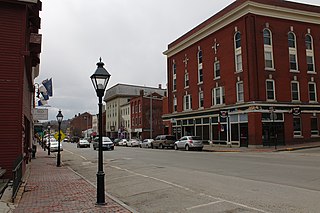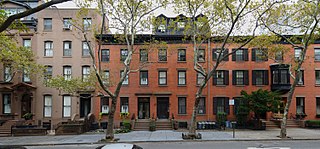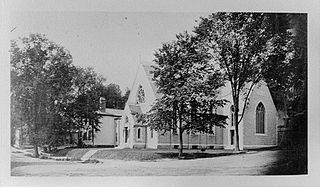
Gardiner is a city in Kennebec County, Maine, United States. The population was 5,961 at the 2020 census. Popular with tourists, Gardiner is noted for its culture and old architecture. Gardiner is a nationally accredited Main Street America community. It is included in the Augusta, Maine micropolitan New England City and Town Area.

Hallowell is a city in Kennebec County, Maine, United States. The population was 2,570 at the 2020 census. Popular with tourists, Hallowell is noted for its culture and old architecture. Hallowell is included in the Augusta, Maine, micropolitan New England City and Town Area.

The Brooklyn Heights Historic District is a historic district that comprises much of the Brooklyn Heights neighborhood of Brooklyn, New York City. It was named a National Historic Landmark in January, 1965, designated a New York City Landmark in November, 1965, and added to the National Register of Historic Places in October, 1966.

Grace Church is an historic Episcopal church at 300 Westminster Street at Mathewson Street in downtown Providence, Rhode Island. It was built in 1845-46 and was designed by Richard Upjohn in the Gothic Revival style.

The Downtown Albany Historic District is a 19-block, 66.6-acre (27.0 ha) area of Albany, New York, United States, centered on the junction of State and North and South Pearl streets. It is the oldest settled area of the city, originally planned and settled in the 17th century, and the nucleus of its later development and expansion. In 1980 it was designated a historic district by the city and then listed on the National Register of Historic Places.

St. Peter's Episcopal Church of Peekskill, New York, United States, is located on the north edge of the city's downtown. It is a three-building complex of stone Late Gothic Revival buildings on a half-acre dating to the late 19th century and added onto at successive later dates.

Centre Street Congregational Church is a historic church at 9 Center Street in Machias, Maine. Built in 1836–37, it is an important early example of Gothic Revival architecture in northern New England, apparently based on an early design by the noted Gothic architect Richard Upjohn. The building was listed on the National Register of Historic Places in 1975. The congregation is affiliated with the United Church of Christ; its current pastor is Rev. Susan Maxwell, M. Div.

The First Baptist Church is a historic church at 1 Park Street in Waterville, Maine. Built in 1826, it is the city's oldest standing public building. It was renovated in 1875 to a design by Francis H. Fassett. It was listed on the National Register of Historic Places in 1976.

The South Parish Congregational Church and Parish House is a historic church at 9 Church Street in Augusta, Maine. Built in 1865, the church is a major Gothic Revival work of Maine's leading mid-19th century architect, Francis H. Fassett, and its 1889 parish house, designed by James H. Cochrane, is a rare example in the state of Stick style architecture. The property was listed on the National Register of Historic Places in 1980. The congregation was established in 1773, when the area was part of Hallowell.

St. Mark's Episcopal Church was a historic church at 9 Summer Street in Augusta, Maine, just west of downtown. The congregation, founded in 1840, occupied an 1886 Gothic Revival stone building designed by Richard M. Upjohn and listed on the National Register of Historic Places in 1984 for its architecture. The congregation moved out in 2015.

St. Matthew's Episcopal Church is an Episcopal Church at 20 Union Street in Hallowell, Maine. The church was built in 1860, and is part of the Hallowell Historic District defined in the National Register of Historic Places.

The Hubbard Free Library is the public library serving Hallowell, Maine. Built in 1879-80, it is the oldest library building in Maine built for that purpose. It was designed by architect Alexander C. Currier to resemble an English country church. Dedicated in 1880 as the Hallowell Library, it was renamed the Hubbard Free Library in 1894, after a $20,000 donation from philanthropist Thomas Hubbard. The building is a contributing property in the Hallowell Historic District.
Alexander Curtis Currier was an American architect and designer of cemetery monuments.

The Charlestown Main Street Historic District encompasses the historic heart of Charlestown, New Hampshire. It is located along Main Street, roughly between Lower Landing Road and Bridge Street, and encapsulates more than two hundred years of the town's history. The district was listed on the National Register of Historic Places in 1987.

The Peter Grant House is a historic house at 10 Grant Street in Farmingdale, Maine. Built in 1830, it is one Maine's oldest surviving examples of Greek Revival architecture, with a temple front overlooking the Kennebec River. It was listed on the National Register of Historic Places on May 17, 1976.

Oaklands, also known locally as Oaklands Castle, is a historic house on Oaklands Farm in southern Gardiner, Maine. The main house of this farm property is a stone Gothic Revival work from the early career of the noted 19th-century architect Richard Upjohn. It was listed on the National Register of Historic Places in 1973.

The Hallowell Powder House is a historic military storage facility on High Street in Hallowell, Maine. Built in 1819, it is one of three documented early 19th-century arms magazines in the state. It was listed on the National Register of Historic Places in 2002 as the Powder House Lot.

The Thomaston Historic District encompasses much of the historic town center of Thomaston, Maine. With a settlement history dating to the 17th century, the town is now a showcase of 19th-century architectural styles up to the 1870s. The district extends for about 2 miles (3.2 km) along United States Route 1, and was listed on the National Register of Historic Places in 1974.

The Row House is a historic multiunit tenement house at 106-114 2nd Street in downtown Hallowell, Maine. Built in 1840, it is one of a small number of row houses built in 19th-century Maine, and is believed to be the oldest built of wood. It was listed on the National Register of Historic Places in 1970.

Vaughan Woods & Historic Homestead is a non-profit nature preserve and historic house museum in Hallowell, Maine. The trails of Vaughan Woods are open to the public daily from dawn to dusk. They may be accessed via two designated trailhead and parking areas. The Hallowell trailhead does not have a street address, but is easily located at the corner of Litchfield Road and Middle Street. The Farmingdale trailhead is behind the Hall-Dale High School tennis courts at 97 Maple Street. Access to the Homestead and gardens is restricted unless a public program is in session.



























